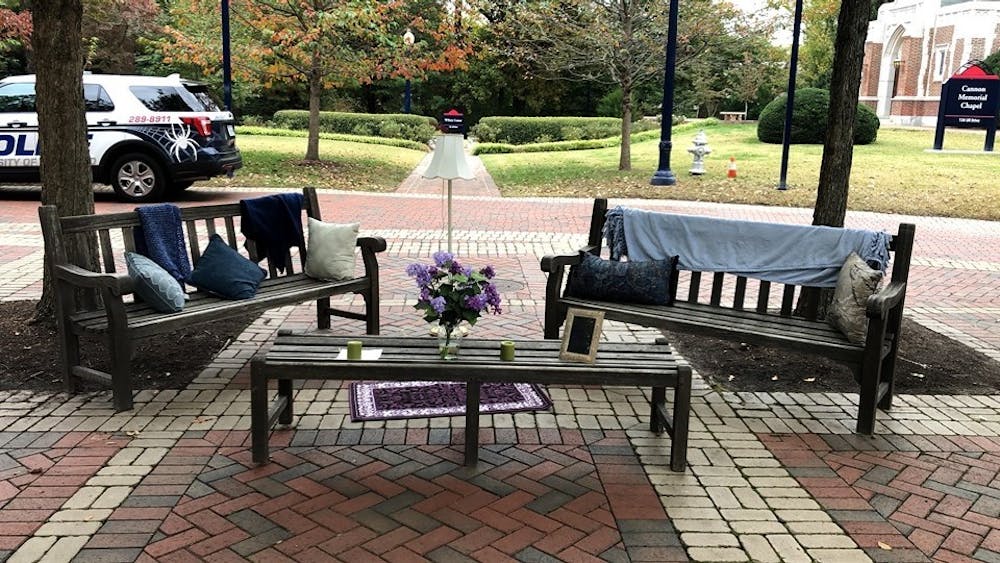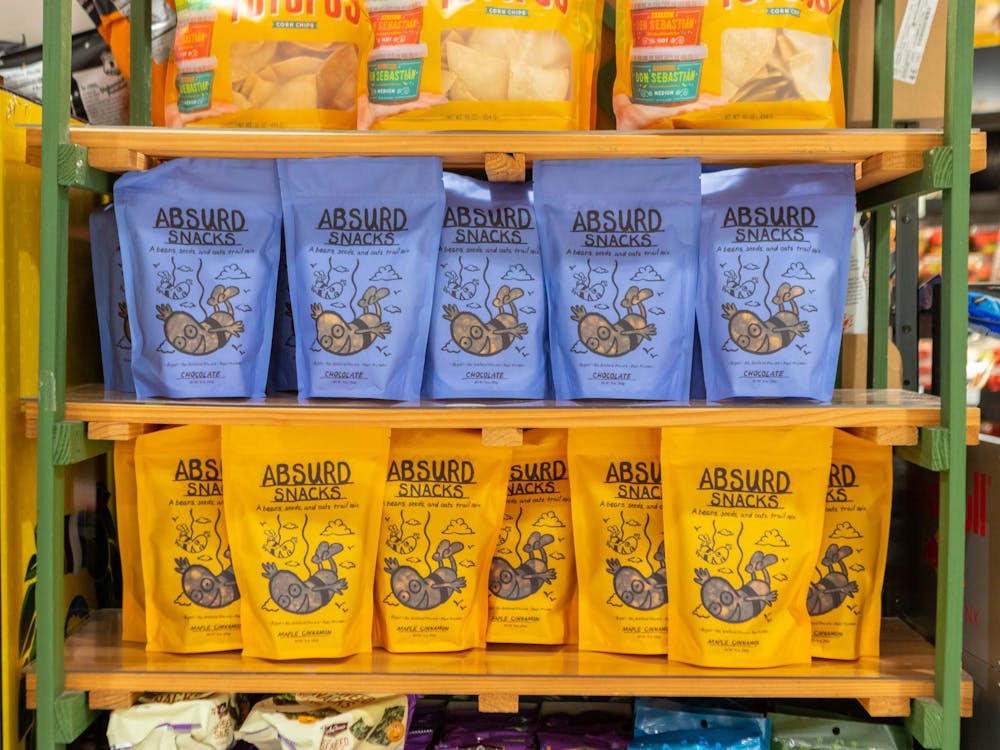When senior Ayele d’Almeida had a class project earlier this semester, she didn’t write an essay or make a presentation to complete the assignment. Instead, she and two teammates went to Goodwill, bought pillows, blankets and other living room essentials and set the items up in the University Forum.
The setup, created for the class Site-Specific Art and Activism, was meant to represent home, d’Almeida said.
“We just wanted to, I guess, do something centered around space or home and how sort of transient it was,” d’Almeida said. “It could kind of be anything, especially with the college campus being a home for students but at the same time, we each have our respective homes wherever we come from. So sort of reminding people of that and making sure that people felt super comfortable in the space was really important for us.”
The living room setup isn’t the only public art piece that has come from the class, which is taught by Dean of Westhampton College Mia Reinoso Genoni. Students have completed various public art projects for the course, from a place to write love letters in the Forum to videos of affirmation in front of Boatwright Memorial Library.
Genoni said her class’ focus was on positive activism in the space of a college campus.
“I want to encourage students to interact with the space of the campus as much as possible, and this [class] was a good way to do that,” Genoni said. “We took as our focus positive disruptions, that is, disruptions that make you look at things differently in positive ways.”
The class, Genoni said, was divided into three four-week units: Love as Political Resistance, Space(s) and Place(s), and Power! and Community. Three changing groups of students created projects based around each of the three units, presenting to each other their takeaways, documentation of their projects and artist statements or manifestos for the projects in the last week of each unit.
Genoni said she had intentionally left the project assignments open-ended, giving students a lot of freedom to decide what to create.
She also said she had encouraged the class to embrace the element of chance, as factors such as weather may impact their site-specific work. Genoni created another type of chance intentionally, through her use of random methods to select project groups.
Senior Kidest Gebre, a member of the class, said that although she normally disliked working on group projects, working in groups had ended up being her favorite part of Genoni’s class. The groups had removed the tensions that often exist in classes by forcing the students to interact with each other, Gebre said.
“As much as it is fun to do art on your own, it was really kind of different to have the different perspectives of students that go here that see the school in a different lens come up … with an impactful project together because we had different things to bring to the table,” Gebre said.
Gebre said her favorite project she had worked on was a love letter project for the first unit, Love as Political Resistance. For this project, Gebre and her group set up a board in the Forum explaining what love could be and invited people to write love letters, she said. The group members then put the letters together into a book.
Enjoy what you're reading?
Signup for our newsletter
Writing love letters was meant to be meditative, Gebre said, but the project also worked as a resistance to the fast-moving culture of campus.
“I think I really loved the love letter project because it forced people to kind of step out of the element of, ‘Okay, I need to go to my next class,’ or ‘I need to think about what I have to do after all my classes,’” Gebre said. “It was that opportunity to say, ‘Okay, let me wind down and reflect for a little bit and reflect on good things and love.’”
Junior Lucy Bliss said she had spent time in the living-room display, created by d'Almeida’s group for the class’ second unit, when it was set up in the Forum.
“It seemed very comfy,” Bliss said. “The pillows and throw stuff and all of the blankets made everything very cozy, despite how hard the benches usually are, and so I sat and kind of enjoyed the sunset while I was working on a sweater, and it felt something strangely close to home, but also kind of not that way.”
Bliss said the public nature of the space had meant that people came up and spoke with her while she was sitting in living room, many of them asking whether she had created it. Although she had been uncertain about what the display was for, she said, it had been a comfortable space.
“People kind of loved the little spark of whimsy that it gave,” Bliss said. “It made me feel like I was in someone’s house, you know, just as a guest, and it felt very, very welcoming.”
For Gebre, students’ engagement in and reflection on the projects she had worked on was meaningful, she said. Genoni’s class also helped her change her own perspectives.
“I have seen art and activism in my work outside of the University of Richmond community,” Gebre said, “but applying it in a very white setting, in a very white institution, was different for me. And I think for better or for worse, learning that and having that experience will enhance my understanding of art and activism.”
Contact copy chief Savannah Wilson at savannah.wilson@richmond.edu.
Support independent student media
You can make a tax-deductible donation by clicking the button below, which takes you to our secure PayPal account. The page is set up to receive contributions in whatever amount you designate. We look forward to using the money we raise to further our mission of providing honest and accurate information to students, faculty, staff, alumni and others in the general public.
Donate Now



